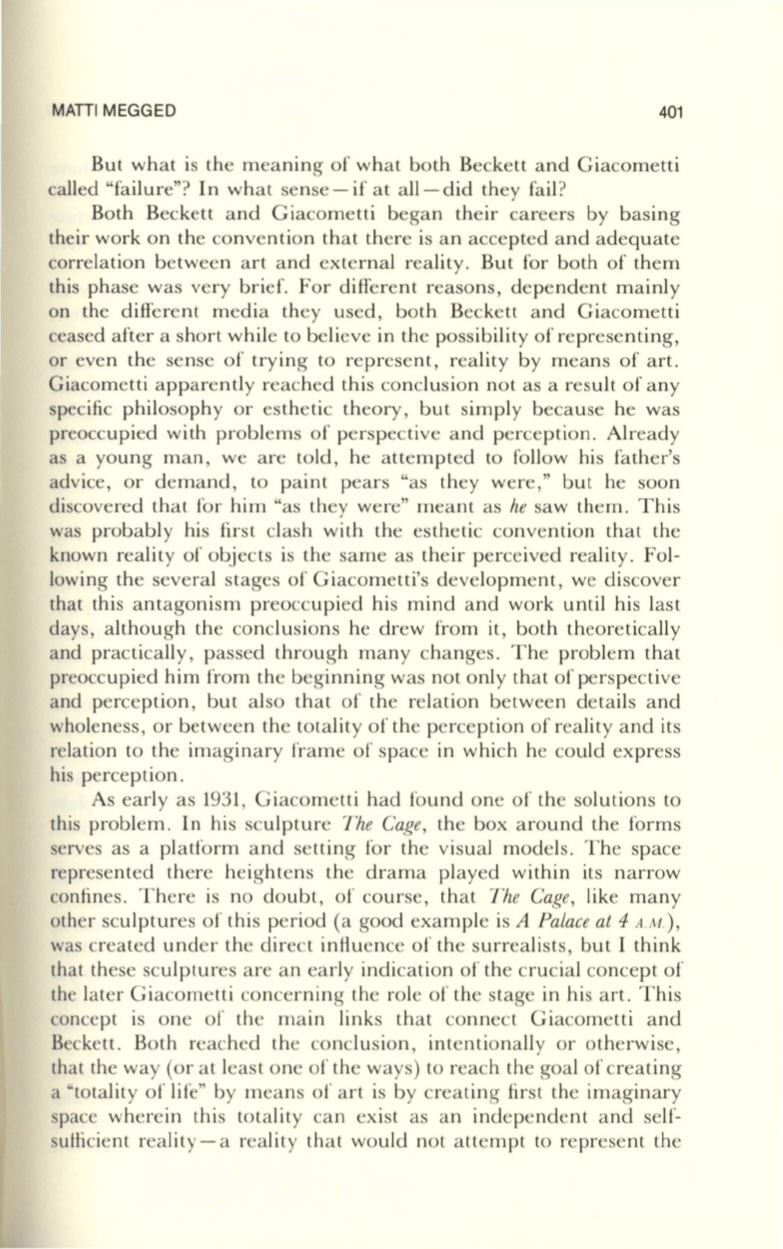
MATII MEGGED
401
But what i the meaning o f wha t bo th Beckett a nd G iacometti
called "fa ilure"? In wha t sense -if a t all-did they fa il ?
Both Beckett a nd Giacome tti began their careers by bas ing
their work on the conventi on tha t there is a n accepted a nd adequa te
correlation between a rt a nd ex ternal reality. But for both of them
this phase was very brie f. For differe nt reasons, dependent mainl y
on the different medi a they used , both Beckett and Gi acometti
ceased after a short whil e to believe in the poss ibility of representing ,
or even the se nse of trying to represent , reality by means of art.
Giacometti a ppa rentl y reached this conclusion not as a result of any
specific philosoph y or e thetic theory, but simpl y because he was
preoccupied with problems o f perspec ti ve a nd perception . Already
as a young ma n , we a re told , he a ttempted
to
follow hi s father's
advice, or dema nd , to pa int pears "as they were," but he soon
discovered tha t fo r him "as they were" meant as
he
saw them. This
was proba bl y hi s first cl as h with the es the tic convention tha t the
known reality of obj ec ts is the same as their perce ived reality. Fol–
lowing the seve ra l stages of Gi acometti's development , we di scover
that this antagoni sm preoccupied hi s mind a nd work until his las t
days, although the conclusions he drew from it, both theoretically
and practically , pas sed through ma ny cha nges. The problem that
preoccupied him from the beginning was not onl y tha t of perspective
and perception , but also tha t of the rela tion between deta ils and
wholeness, or betwee n the totality of the perception of reality a nd its
relation to the imagina ry frame o f space in whi ch he could express
hi perception .
As earl y a 1931, Gi acometti had found one o f the solutions to
this problem . In hi s sculpture
The Cage,
the box a round the forms
erves as a pl a tfo rm a nd se tting for the visual models. The space
represented there heightens the drama pl ayed within its na rrow
confines . There is no doubt , of course, tha t
The Cage,
like many
other sculptures o f thi s period (a good exampl e is
A Palace at
1-
AoM),
was created under the direc t influence o f the surrealists, but I think
that these sculptures a re a n earl y indica ti on of the crucia l concept of
the later Gi acome tti conce rning the role of the stage in his a rt. This
concept is one o f the ma in links tha t connec t Gi acometti a nd
Beckett. Bo th reached the conclusion , intentionall y or otherwi se,
that the way (or a t leas t one o f the ways) to reach the goal of creating
a "totality o f life" by means o f a rt is by crea ting first the imaginary
space wherein thi s to ta lity can exi st as a n inde pende nt a nd self–
sufficient reality - a reality tha t would no t a ttempt to represent the


